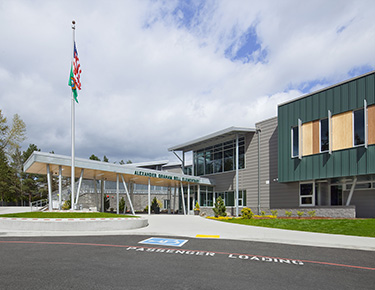|
Subscribe / Renew |
|
|
Contact Us |
|
| ► Subscribe to our Free Weekly Newsletter | |
| home | Welcome, sign in or click here to subscribe. | login |
Construction
| |
 |
August 28, 2014
What to consider when building a new school next to the old one
Heery International

Finnegan
|

Beaudine
|
Many urban school districts frequently face a dilemma.
Their schools are aging, providing a less than optimal environment for modern teaching techniques and the new technology that underpins education today. Usually, it is better and more cost effective to construct a new facility than renovate an existing school.
Problems arise, however, when open land for building new schools is scarce. This often directs district leaders to building a new school on the grounds of the existing facility, typically while class is in session. In those cases, construction on occupied sites needs to be managed thoroughly to ensure safety to students, staff and the public and to minimize impacts to the educational process.
As a guide, schools leaders need to consider the following points before moving forward with school construction on an occupied site.
It’s a puzzle
Fitting a new school onto an occupied site requires a great deal of creativity. Designers, school officials and the construction manager all need to work together to determine the best approach to building a school on the available land and phase construction so that learning can happen with a minimum of interruption.
Puzzling out the new construction requires a significant amount of coordination. Often, it means designing a new building around the existing one and keeping as much of the old facility in use as long as possible during construction.
Lake Washington School District’s Rush Elementary was built in five separate phases to minimize the impact on school operations. The first two phases were dedicated to selective demolition of the first grouping of classrooms and construction of a new academic wing.
Once completed, students, teachers and administrators moved into the new wing. Next, the remainder of the original facility was demolished except for the original gymnasium, and was replaced with a new wing for the art, science, music and physical education programs, as well as administrative and kitchen operations. During the final phase, completed during the summer, the original gym was demolished, and parking lots, a new bus drop-off loop and a parent drop-off lane were installed.
Plan for safety
Before a shovel hits the ground on any school project, the construction managers and contractors develop detailed plans to maintain a safe school environment.
At Lake Washington’s Bell Elementary, the new building was constructed less than 10 feet from occupied spaces. The construction managers spent a great deal of time thinking through each scenario for safety and school impacts. In addition to moving students into temporary buildings, the construction managers and design team worked closely with the school and the district to make sure there were no compromises with safety and that any impacts on learning were kept to a minimum.
Planning usually also entails working with the local government officials. Throughout the project, construction managers worked closely with the fire department and buildings department to ensure the codes and safety minimums are met.
Local police officers are often hired, most notably during the first two weeks of each school year or phase in construction, to direct traffic through the new traffic patterns that almost always occur during construction.
Work with the principal
In any project like this, making sure school operations are not impacted is a key priority. Every school has its own rhythm of testing and other significant instruction periods during the year that have to be respected, even as classroom space gets shuffled around.
To ensure this happens smoothly, it is important to maintain an ongoing conversation with the principal and other key administrators to identify those sensitive times and plan accordingly. Noise, dust and odors are all critical concerns. When an overlap cannot be avoided, the construction manager and contractor shift the impactful activity to off hours, either before or after test times.
The principal is also an effective channel of information to parents, teachers and students. Spokane Public Schools allows the principal to assign a teacher, coach or assistant principal to work with the construction manager on day-to-day issues.
If teachers have a complaint, for instance, or the construction manager needs to share information about traffic changes, this individual can serve as the point of communication between the school and the construction manager. This arrangement relieves the principal from having to oversee the construction project while also trying to run the school.
Get everyone involved
Involving teachers and students in the construction project in appropriate ways can not only help take the sting out of the inconvenience, but can also make the whole project go smoother.
Groundbreaking is the first best opportunity to get the community involved. Additionally, including teachers and students in events can help make for a memorable moment.
For example, at Bell Elementary every student was given the chance to sign the last steel member once it was in place. The signatures may never be seen again but the students will always know they are there.
Formal observation areas, a place where the view is good and safety is best, give students and teachers a chance to keep an eye on the progress of the work. At Ferris High School in Spokane a group of students and teachers who called themselves the “crane crew” spent their lunch breaks watching the tower crane and other big equipment work. They even made T-shirts for themselves.
The final opportunity is move-in day. The first day of school — or first day in the new building — is always a great day. Students often cannot believe their eyes and there is a definite air of excitement and joy as they marvel at their new school. Remember to take advantage of it.
Mike Finnegan is the Northwest regional director of project management with Heery International. David Beaudine is a senior project manager with Heery International.
Other Stories:
- Can you design a school theater that pleases everyone?
- What schools can learn from Starbucks
- Renton preschool offers kids a running start
- How replacing an old building is like selling New Coke
- Locals designers help rebuild schools in Haiti damaged by earthquake
- WSU technology lab combines work with show
- Do art and science mix? Lab designers give it a try




